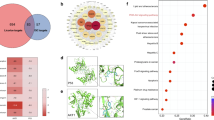Abstract
Resveratrol (3,4′,5-trihydroxystilbene, Res), a naturally occurring polyphenol, exhibits antioxidant, anti-inflammatory, potential chemopreventive and chemotherapeutic properties in preclinical studies. To further understand its potential clinical efficacy and safety, effect of Res at 10−9–10−4 mol/L on human embryonal kidney (HEK293) cell proliferation and its potential mechanism were investigated in present study. Cell viability was detected by using trypan blue dye exclusion method. Cell cycle and apoptosis were analyzed by flow cytometry with propidium iodide stain. Activation of nuclear factor-kB (NF-kB) was determined by luciferase reporter gene assay using stably transfected HEK293/kB-1uc cells. Secretion of human interleukin-8 (hIL-8) was measured by ELISA. Our results show that HEK293 cell proliferation was significantly stimulated by 10−7 mol/L Res after treatment for 48 hours, or by 10−8-10−7 mol/L Res combinated with 10 ng/mL TNFα for 24 h, but was suppressed by 10−4 mol/L Res with or without TNFα. Both endogenous and TNFα-induced NF-kB activation were downregulated by Res at 10−7 mol/L, but were upregulated at 10−4 mol/L. With 10−4 mol/L Res, the content of secreted IL-8 was increased, and apoptosis rate was increased from less than 5% to 10%, together with significant cell-cycle arrest in S phase. TNFα has coordinative effects with Res on HEK293 cell apoptosis, cell-cycle arrest and IL-8 secretion. These results indicate that Res promotes cell proliferation at low concentration through down-regulation of NF-kB activation in HEK293, but suppresses its growth at high concentration through up-regulation of NF-kB activation, increasing IL-8 and cell-cycle arrest. As resveratrol has dual regulatory effect on cell proliferationin vitro, comprehensive evaluation of its potential clinical utility is needed.
Similar content being viewed by others
References
Langcake, P., Pryce, R. J., The production of resveratrol byVitis vinifera and other members of the Vitaceae as a response to infection or injury, Physiol. Plant Pathol., 1976, 9: 77–86.
Gusman, J., Malonne, H., Atasst, G., A reappraisal of the potential chemopreventive and chemotherapeutic properties of resveratrol, Carcinogenesis, 2001, 22(8): 1111–1117.
Aziz, M. H., Kumar, R., Ahmad, N., Cancer chemoprevention by resveratrol:In vitro andin vivo studies and the underlying mechanisms, Int. J. Oncol., 2003, 23(1): 17–28.
Aggarwal, B. B., Bhardwaj, A., Aggarwal, R. S. et al., Role of resveratrol in prevention and therapy of cancer: Preclinical and clinical studies, Anticancer Res., 2004, 24(5A): 2783–2840.
Howitz, K. T., Bitterman, K. J., Cohen, H. Y. et al., Small molecule activators of sirtuins extendSaccharomyces cerevisiae lifespan, Nature, 2003, 425(6954): 191–196.
Culpitt, S. V., Rogers, D. F., Fenwick, P. S. et al., Inhibition by red wine extract, resveratrol, of cytokine release by alveolar macrophages in COPD, Thorax., 2003, 58(11): 942–946.
Corder, R., Crozier, A., Kroon, P. A., Drinking your health? It’s too early to say, Nature, 2003, 426(6963): 119.
Goldberg, D. M., Yan, J., Soleas, G. J., Absorption of three wine-related polyphenols in three different matrices by healthy subjects, Clin. Biochem., 2003, 36(1): 79–87.
Crowell, J. A., Korytko, P. J., Morrissey, R. L. et al., Resveratrol associated renal toxicity, Toxicol. Sci., 2004, 82(2): 614–619.
Kucharczak, J., Simmons, M. J., Fan, Y. et al., To be, or not to be: NF-kB is the answer-Role of Rel/NF-kappaB in the regulation of apoptosis, Oncogene, 2003, 22(56): 8961–8982.
Estrov, Z., Shishodia, S., Faderl, S. et al., Resveratrol blocks interleukin-1beta-induced activation of the nuclear transcription factor NF-kB, inhibits proliferation, causes S-phase arrest, and induces apoptosis of acute myeloid leukemia cells, Blood, 2003, 102(3): 987–995.
Takada, Y., Bhardwaj, A., Potdar, P. et al., Nonsteroidal anti-inflammatory agents differ in their ability to suppress NF-κB activation, inhibition of expression of cyclooxygenase-2 and cyclin D1, and abrogation of tumor cell proliferation, Oncogene, 2004, 23(57): 9247–9258.
Manna, S. K., Mukhopadhyay, A., Aggarwal, B. B., Resveratrol suppresses TNF-induced activation of nuclear transcription factors NF-κB, Activator protein-1, and apoptosis: Potential role of reactive oxygen intermediates and lipid peroxidation, J. Immunol., 2000, 164(12): 6509–6519.
Donnelly, L. E., Newton, R., Kennedy, G. E. et al., Anti-inflammatory effects of resveratrol in lung epithelial cells: Molecular mechanisms, Am. J. Physiol. Lung Cell Mol. Physiol., 2004, 287(4): L774–783.
Yin, H., Cheng, G. F., Anti-inflammatory drugs differ in their abilities to regulate NF-κB activation, Acta Pharm. Sin., 2005, 40(6): 491–495.
Xiong, X. Y., Wu, Y. M., Zou, Y. et al., Comparison of effects of three drugs for Alzheimer’s disease on viability of mouse cortical neuronsin vitro, Chin. J. Clin. Pharmacol. Ther., 2004, 9(4): 399–402.
Boscolo, P., del Signore, A., Sabbioni, E. et al., Effects of resveratrol on lymphocyte proliferation and cytokine release, Ann. Clin. Lab. Sci., 2003, 33(2): 226–231.
Fulda, S., Debatin, K. M., Sensitization for anticancer drug-induced apoptosis by the chemopreventive agent resveratrol, Oncogene, 2004, 23(40): 6702–6711.
Fuggetta, M. P., D’Atri, S., Lanzilli, G. et al.,In vitro antitumour activity of resveratrol in human melanoma cells sensitive or resistant to temozolomide, Melanoma Res., 2004, 14(3): 189–196.
Harper, N., Farrow, S. N., Kaptein, A. et al., Modulation of tumor necrosis factor apoptosis-inducing ligand-induced NF-kB activation by inhibition of apical caspases, J. Biol. Chem., 2001, 276(37): 34743–34752.
Pellegatta, F., Bertelli, A. A., Staels, B. et al., Different short- and long-term effects of resveratrol on nuclear factor-KB phosphorylation and nuclear appearance in human endothelial cells, Am. J. Clin. Nutr., 2003, 77(5): 1220–1228.
Jeong, W. S., Kim, I. W., Hu, R. et al., Modulatory properties of various natural chemopreventive agents on the activation of NF-kappaB signaling pathway, Pharm. Res., 2004, 21(4): 661–670.
Shen, F., Chen, S. J., Dong, X. J. et al., Suppression of IL-8 gene transcription by resveratrol in phorbol ester treated human monocytic cells, J. Asian Nat. Prod. Res., 2003, 5(2): 151–157.
Imamura, R., Konaka, K., Matsumoto, N. et al., Fas ligand induces cell-autonomous NF-kB activation and IL-8 production by a mechanism distinct from that of TNF-alpha, J. Biol. Chem., 2004, 279(45): 46415–46423.
Author information
Authors and Affiliations
Corresponding author
About this article
Cite this article
Yin, H., Cheng, G. Dual regulatory effects of resveratrol on activation of NF-κB and cell proliferation in human embryonal kidney 293 cells. Chin.Sci.Bull. 50, 770–774 (2005). https://doi.org/10.1007/BF03183677
Received:
Accepted:
Issue Date:
DOI: https://doi.org/10.1007/BF03183677




